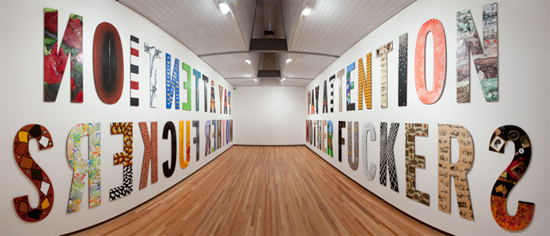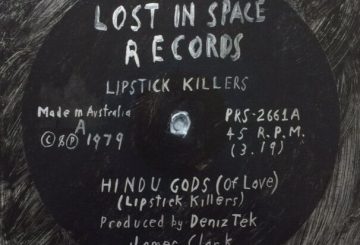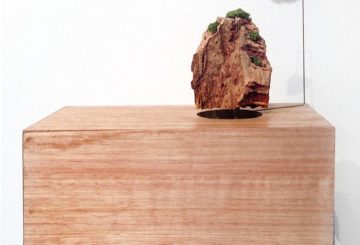Sharne Wolff on speaking proppa…
We’re not listening. At least that’s what Tony Albert and his collaborators are trying to tell us with his major new installation piece Pay Attention Mother Fuckers 2009-2010 recently installed at the National Gallery of Australia (NGA) as part of Undislosed: The 2nd Indigenous Arts Triennial. Albert’s piece appropriates a work of the same name made in 1973 by American artist Bruce Nauman – a print of which is held in the collection of the NGA.
Pic: Jennifer Herd Richard Bell Megan Cope Gordon Hookey Laurie Nilsen Tony Albert Vernon Ah Kee [Image courtesy proppaNOW and the State Library of Queensland
At the same time but a long way north from Canberra another important exhibition documenting Brisbane’s well-known ‘proppaNOW’ art collective has recently been launched at the State Library of Queensland (SLQ). According to an article by Nicholas Rothwell in The Australian (Surveying the Landscape 5/6 May 2012), Albert is the ‘enfant terrible’ of the seven member ProppaNow group alongside fellow indigenous artists Vernon Ah Kee, Richard Bell, Jennifer Herd, Gordon Hookey, Laurie Nilsen and newest member, Megan Cope. The proppaNow collective was formed around 2004 for the purpose of giving a voice to so-called ‘urban’ Aboriginal artists who at the time felt they were being ignored as individuals or dubbed ‘inauthentic’ by all sides of the art world. The group adopted the name proppaNOW after a conversation between Bell and Ah Kee – they wanted to form a ‘proppa’ group and it had to be about ‘Now’.
Each proppaNOW artist has examples of their work in this exhibition but it’s more library or museum style than one you might see at the Gallery of Modern Art or the Queensland Art Gallery – both of which flank the SLQ. The idea is to set the art within the context of proppaNOW’s social history. At only 8 years old it may seem rather odd to chart a ‘history’ but this group has moved ahead with such leaps and bounds that a life of less than one decade seems more like several. It’s also obvious from the exhibition itself, and on speaking to the artists, that the members of proppaNOW are quite aware any ‘history’ being made by them is happening in the present – it’s still a work in progress, albeit slow. (As if to emphasise the relevance of the show, some of the artists were late to the opening of the exhibition due to protests about the expulsion of Aboriginal people from West End’s Musgrave Park – about which Meg Lee wrote an excellent post for the University of Queensland’s Society of Fine Arts).
Tony Albert, PAY ATTENTION MOTHER FUCKERS 2009 – 2010, mixed media on custom-made, laser-cut hand-finished aluminum letters each letter 75 cm high, total length 2142 cm.
P – Judith Inkamala
A – Archie Moore
Y – Abe Muriata
A – Theresa Beeron
T – Jason Wing
T – Megan Cope
E – Joanne Currie
N – Ninney Murray
T – Laurie Nilsen
I – Arthur Pambegan Jr.
O – Leah King-Smith
N – Daniel Boyd
M – Jennifer Herd
O – Judy Watson
T – Bianca Beetson
H – Dale Harding
E – Rahel Ungwanaka
R – Gary Lee
F – Vernon Ah Kee
U – The Last Kinection
C – Gordon Hookey
K – Craig Koomeeta
E – Tonya Grant
R – Richard Bell
S – Maureen Beeron
The work produced by each of the proppaNow artists is quite distinct and they maintain the view that they have no intention to represent all Aboriginal people. To varying degrees all the work made by proppaNOW is political. The members of the group do not recognise a choice in this regard. They make work about themselves, their families and their country. It might be called ‘urban’ but that’s arguably a white person’s term and a white person’s construct. The art being made by this Brisbane group and other Aboriginal people living in urban centres is actually no different to that being made by ‘traditional’ artists in remote communities (who, make no mistake, are also making political art).
Some of the work is subtle, some ironic, some beautiful and some just blatantly confrontational. Youngest member Megan Cope was asked to join proppaNOW in mid 2011 and says it provides her with ‘a safe place to discuss things important to her practice, identity and experience as an Aboriginal person’. Her current practice is informed by landscape and in particular the attachment of family to a particular environment. Cope is a descendant from the Quandamooka region (North Stradbroke Island) in South East Queensland. She says she hopes her work will ask people to question their own identities and histories as Aboriginal people do on a daily basis. When asked about the political nature of the group’s work, she says,
“Some people don’t understand why Aboriginal people make political art. But there’s no possible way you can produce art that’s not political. If you are born Aboriginal you are born politicised. How you resolve that is up to you but if you become an artist then automatically you produce political art because you’re making work about your life. It follows. Until equality is reached in this nation, Aboriginal people will produce political art.”
Although the artists of proppaNOW are as much activists as they are artists, there’s no doubt there’s plenty of artistic talent in the proppaNOW group and ultimately it’s the quality of the art that will determine its power. Richard Bell started his artistic career in the souvenir market pumping out thousands of small works to be purchased by tourists. He decided to become a ‘fine’ artist after realising that not only would he reach a bigger audience he could ‘get away with almost anything in the name of art and not get arrested’. Well known for his visually arresting works appropriating the big names of the art world, Bell became famous after his win in the Telstra National Aboriginal & Torres Strait Islander Art Award in 2003 with a large painting formally entitled ‘Scientia E Metaphysica (Bells Theorem) 2003’ but also colloquially by the text appearing on its face – ‘Aboriginal Art it’s a White Thing’. This was followed by ‘We were here first’, ‘Pay the rent’, and many others. At SLQ he has exhibited a small work with superimposed text ‘Domestic Violence Sucks’. As with most of Bell’s work you find yourself reacting to the work – in this case by nodding in agreement. To view one of Bell’s videos can be simultaneously funny and scary.
Original ProppaNow member Jennifer Herd is sometimes referred to as the matriarch of the group. Aside from her artistic practice she lectures at the Queensland College of Art (Griffith University) and is a curator and mentor. Herd’s practice has involved research into the myths of post settlement Australian history as she investigates ways to achieve better access to land rights for Aboriginal people – particularly topical in this the 20th anniversary year since the High Court’s Mabo decision. Unlike the male members of the group, she’s been unable to achieve the same prominent gallery representation or high prices for her work, something to which many other female artists can relate.
Gordon Hookey’s work often considers embedded racist attitudes in sport and what he terms the ‘Black C’, a term derived from an incident involving Andrew Johns’ racial slur in 2010. At the opening of the exhibition Hookey was pleased that the rugby league State of Origin game was to be played the following week in Brisbane. It seemed appropriate somehow. Laurie Nilsen has exhibited an emu sculpture made primarily from barbed wire and a large drawing on paper of a barb from the wire fence – a particularly beautiful piece representing both a tool of dispossession and environmental degradation. When asked about the emu Nilsen tells me he once found thirty emus trapped in a fence surrounding a waterhole. Most other animals are big enough to jump over or small enough to crawl under. Not old man emu. He circles the fence for a few days until eventually he tries to enter and ends up killing himself. Nilsen has constructed his sculpture from the murder weapon – the same wire also used by farmers to keep Aboriginal people off their own lands. The emu also happens to be his family totem.
Vernon Ah Kee has exhibited drawings here from his ‘Unwritten’ series. The aim is to strip away ideas of the ‘primitive’ and the ‘exotic’ from images of Aboriginal people. Ah Kee spent his childhood obsessed with drawing and spent years finessing his technique. Although he has a broad practice that includes his angry but witty text based works, digital video and sculpture, it’s Ah Kee’s drawings which are contemporary, progressive and unparalleled. It’s impossible to forget these faceless black on white portrait images that emerge almost ghostly from the slash of pencil lines on paper. Despite the apparent subtlety of his work, Ah Kee is relentless in his pursuit of rights for Aboriginal people and seems unperturbed if it makes his audience feel uncomfortable.
ProppaNow is as much about politics as it is a community of artists although the work varies in its overt political intensity. On the one hand to dismiss this art as too political is surely missing the point. proppaNOW is educating, sharing knowledge and beliefs, reflecting, invoking memory, making commentary, creating beauty and teaching history. In the alternative the political thrust of the work becomes a two-edged sword with many writers unwilling to engage in critical discourse with the work produced for fear of a backlash. Although the artists provide a critical forum for each other it is essential for their success that their work and the work of other Aboriginal artists is discussed within mainstream forums of contemporary art debate. The SLQ exhibition is helping to give them a voice and to explain the context in which the work is made.
proppaNOW are aware they tread a fine line. To achieve results and get the audience to listen, is it better intimidate and coerce or to encourage and create empathy? The latter arguably requires inventiveness and much patience, the former runs the risk of being counter productive. The challenge for the members of proppaNOW is to make art that is provocative but not so that it alienates and offends the very audience it is directed to. Films such as Samson and Delilah and the recent Toomelah have managed to achieve this balance in the same way musicians like Kev Carmody and Geoffrey Gurrumul Yunupingu are seducing their audiences.
Some Australians are already listening. Tony, you have our attention. Now what are you going to do with it?
In addition to the exhibition the SLQ is hosting a monthly series of Nights by the Fire with members of the proppaNOW group. For details visit www.slq.qld.gov.au/whats-on
ProppaNOW
proppaNOW: A social history of Queensland’s leading Aboriginal art collective.
State Library of Queensland, Brisbane
Until 10 September 2012





“The latter arguably requires inventiveness and much patience, the former runs the risk of being counter productive.” Very true… I have found much of Albert’s work rather boring, regardless of the message and the colour of the artist’s skin. Bell’s work on the other hand is much more engaging. The installation in the Triennial referred to in this article offered me nothing in terms of engagement, unlike Ah Kee’s video installation from Palm Island. A friend who attended the exhibition with me was in tears watching this work. Artists who produce confrontational work that is activist in nature, always run the risk of alienating the audience. However one can still feel moved while being alienated. Albert’s piece misses the mark all together in my opinion.
Pingback: It’s gotta be proppaNOW. « Wolff.